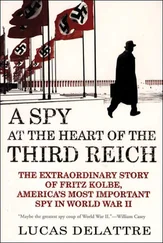1 I draw heavily here on The Main Enemy: the Inside Story of the CIA’s Final Showdown with the KGB by Milt Bearden and James Risen (Random House, 2003). The ‘Gavrilov’ backchannel is discussed on p. 184.
2 Battleground Berlin: CIA vs. KGB in the Cold War by David Murphy and Sergei Kondrashev (Yale University Press, 1999).
3 ‘Death of a Perfect Spy’ by Elaine Shannon, Time , 24 June 2001 http://www.time.com/time/magazine/printout/,8816,164863,0.html
4 This article gives a good indication of what the West was trying to buy – and by implication what it would obtain by other means if necessary. ‘US Is Shopping as Soviets Offer To Sell Once-Secret Technology’ by William Broad, New York Times , 4 November 1991 http://www.nytimes.com/1991/11/4/world/us-is-shopping-as-soviets-offer-to-sell-once-secret-technology.html
5 The KGB cannily tried to revive the story of ‘Red Web’ to derail the Baltic independence movements in the late 1980s. The aim was to contrast the frankness of Gorbachev’s approach to history with the silence of the West about its use of fascist collaborators in the post-war era, and the cynical and incompetent behaviour of the CIA and SIS. In November 1987 the KGB brought its greatest trophy, Kim Philby, to Riga, and filmed him in a meeting with Lukaševičs, purportedly (and quite possibly truly) the first time that the two men had met. Philby’s lizard-like face lights up as he discusses Operation Jungle with his host (who spoke fluent English, having been posted to London, under a pseudonym, as a reward for his efforts). The initial aim was to demoralise the Baltic independence movements by highlighting the past. The Soviet authorities then made the material, and former KGB officers, and surviving partisans, available to Mr Bower. In the West, SIS – never before the subject of an unauthorised and unflattering exposé – was furious, telling retired officers that they risked their pensions if they talked to Mr Bower. He short-circuited the ban by talking to CIA veterans and pensionless émigrés. But the tide of history was running too strongly, and Estonians, Latvians and Lithuanians were in no mood to believe Soviet propaganda of any kind, even when it was true. Mr Bower, quite unfairly, was assumed to be a Kremlin stooge.
An early example of KGB propaganda is Polymany s polichnim: sbornik faktov spionazhom protiv SSSR (Caught red-handed: a collection of facts about espionage against the USSR) , State Publishing House for Political Literature, Moscow, 1963. See also KGB, Stasi ja Eesti luureajalugu (KGB, Stasi and Estonian intelligence history ) by Ivo Juurvee http://rahvusarhiiv.ra.ee/public/TUNA/Artiklid_Biblio/JuurveeIvo_KGB_Stasi_TUNA2008_2.pdf
6 The Friends: Britain’s post-war secret intelligence operations by Nigel West (Weidenfeld and Nicolson, 1988).
7 A gripping account of his defection comes in his autobiographical Tower of Secrets (Naval Institute Press, 1993).
8 The journalist David Satter, then the Moscow correspondent of the Financial Times , gives a vivid account of his attempt to meet dissidents in Estonia in 1977.
‘So,’ I said, ‘you are trying to tell me that someone arranged for you to meet me in Tallinn?’ Several of them nodded their heads yes. ‘Show me some identification,’ I said. ‘No, we don’t show any identification,’ said the sandy-haired man, shaking his head firmly. ‘I’m glad to hear that,’ I said, ‘because for a moment it occurred to me that you might actually be the dissidents, but if you won’t identify yourselves, it only proves to me that you’re the KGB.’ The superficial politeness that had prevailed up until that point disappeared. The tall, solemn member of the group leaned over the table. ‘I spent twelve years in the camps,’ he said. ‘My friends have spent six, seven, and eight years in the camps. You’re not going to treat us like a bunch of niggers.’
Stung by the rebuke, Satter resolved to trust his hosts, who gave every appearance of being terrified by KGB surveillance and of making elaborate precautions to avoid it. Only when he returned to Moscow did he find out that the entire meeting had indeed been a charade staged to find out more about his own views and contacts. The real Estonian dissidents had waited in vain for their visitor. ‘Never Speak to Strangers: A memoir of journalism, the Cold War, and the KGB’ by David Satter, The Weekly Standard, 6 August 2007 (vol. 12, no. 44) http://www.weeklystandard.com/Content/Public/Articles/00/00/13/932plsuu.asp. Satter’s article ‘The Ghost in the Machine’ in the Financial Times on 5 April 1977 was none the less a remarkable event, which not only shocked Western Sovietologists who thought the Baltic struggle for independence was over, but also boosted spirits in the region.
9 See https://www.cia.gov/news-information/featured-story-archive/2010-featured-story-archive/colonel-penkovsky.html. Penkovsky passed his messages in a park to a British diplomat’s wife wheeling a pram.
10 Next Stop Execution (Macmillan, 1995) is one of Mr Gordievsky’s many books.
11 ‘Cold War Spy Tale Came to Life on the Streets of Moscow’ by Matt Schudel, Washington Post, 20 April 2008 http://www.washingtonpost.com/wp-dyn/content/article/2008/4/19/AR2008041902071_pf.html
12 Bearden/Risen, p. 382.
13 Paul Goble, then at the CIA, deserves special mention here. His blog has been essential reading http://windowoneurasia2.blogspot.com
14 ‘Transitional Justice in the Former Yugoslavia’ http://ictj.org/sites/default/files/ICTJ-FormerYugoslavia-Justice-Facts-2009-English.pdf
15 Entitled Lähtealused Eesti eriteenistuste väljaarendamiseks (Guidelines on the development of Estonia’s special services) , it is still classified and my requests to view it have been politely rejected. See Eesti nähtamatud mehed (Estonia’s invisible men) by Toomas Sildam and Kaarel Tarand, Postimees, 20 January 1997 http://www.postimees.ee/luup/97/2/top.htm
16 Interview with the author, March 2011.
17 ‘ Riigikogu (Estonian Parliament) Committee of Investigation to Ascertain the Circumstances Related to the Export of Military Equipment from the Territory of the Republic of Estonia on the Ferry Estonia in 1994, Final Report.’ Available at http://www.riigikogu.ee/public/Riigikogu/Dokumendid/estcom_eng.pdf
18 See ‘Death in the Baltic, the MI6 Connection’ by Stephen Davis, New Statesman, 23 May 2005 http://www.newstatesman.com/200505230019and this report (in Swedish) by the judge Johan Hirschfeldt ‘Transport of military material on the MV Estonia in September 1994’ http://www.estoniasamlingen.se/textfiles/Fo_2004_6.pdf
19 ‘ In der Bermuda Dreieck der Ostsea’ (‘In the Bermuda Triangle of the Baltic Sea’), Der Spiegel, 23 December 1999 http://www.spiegel.de/panorama/,1518,57520,0.html. I am grateful to Jutta Rabe for her help.
20 I was the managing editor and major shareholder of the Baltic Independent , which in late 1994 merged with the Baltic Observer to become the Baltic Times www.baltictimes.com
21 A particular puzzle concerns the fate of the captain, Arvo Piht, and several other survivors. They include Lembit Leiger (chief engineer), Viktor Bogdanov (ship’s doctor), Kaimar Kikas (navigation officer), Agur Targama (fourth engineer), Tiina Müür (manager of the duty-free shop) and Hannely Veid and Hanka-Hannika Veide (dancers). All eight were seen by multiple witnesses leaving the vessel on the same life raft and were recorded as rescued in multiple lists compiled on shore. In several cases (including Captain Piht and the twins) their families received phone calls informing them that their relatives were safe – in the twins’ case using a nickname known only to close friends and family. The twins’ parents say they have received phone calls from their daughters; they believe they were until recently living in San Diego. Captain Piht’s rescue was also reported in the New York Times , in an article by Richard Stevenson on 1 October 1994 http://www.nytimes.com/1994/10/1/world/investigators-cite-bow-door-in-estonian-ferry-s-sinking.html
Читать дальше












